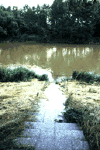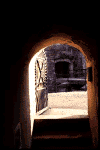
|

|

|
| A bed,
wash bowl, utensils, and clothes lines were in a small room just like
this.
|
Children
played on a playground to trick the Red Cross that they were treated
right.
|
These
small courtyards would hold hundreds of prisoners.
|

|

|

|
| Many
prisoners had to walk to Theresienstadt with their luggage. Many
also had to walk to trains taking them East.
|
Many entered through this entrance to
Theresienstadt and hardly any left for freedom.
|
Nazi propagandists used this library,
built in Theresienstadt, to give false images that the Jews were treated
right with having rights to books.
|

|

|

|
| This is
the Main street of Theresienstadt that many spent day and night cleaning
by hand.
|
Nazis made paper money that replaced
real money that Jews were forbidden to use.
|
Young Josef Novak, a Theresienstadt
boy prisoner, drew this while he stayed there. He shows residents
being hung, which was quite normal.
|

|

|

|
| This is
a picture of the Ohre River, clouded by the ashes of those cremated
prisoners.
|
This is a picture of Rabbi Leo
Baeck. A survivor of Theresienstadt.
|
This is a closer picture of the
entrance to Theresienstadt. Notice the Nazi ruse, "Work makes one
free."
|

|

|

|
| A
soccer game was played to deceive the Red Cross that Theresienstadt was
wonderful.
|
This is a birds eye view drawing of
Terezin.
|
Prisoners were tortured in underground
bunkers in the old fortress.
|

|

|

|
| These
cattle car trains brought in the prisoners. These trains also took
many East.
|
Many were thrown into tunnels like
this to stay there.
|
This is a picture of Theresienstadt.
|

|
|
|
| Women
stayed separate in bunkers like this.
|
|
|
